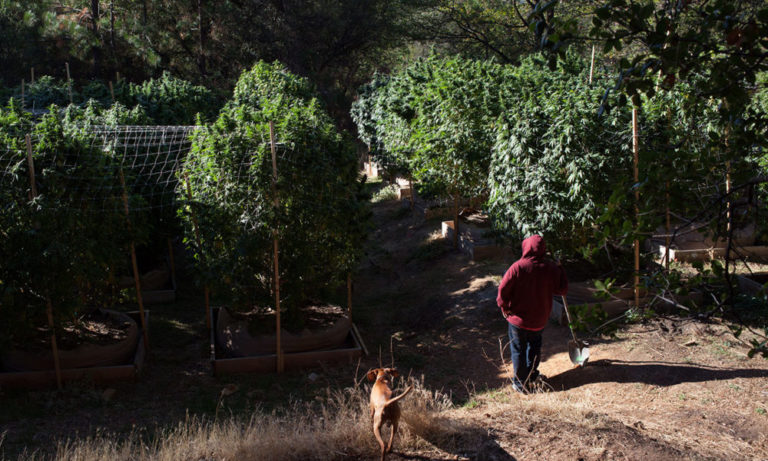
[ad_1]
All outdoor cannabis crops have the potential to be destroyed by one or two of the various problems lurking in the wilderness, unlike indoor growing where plants are protected. In checking on the crop, make sure to keep an eye on the little details that will spell trouble later. There are a few different things to look for:
Aphids
An aphid infestation is a hard infestation to get rid of. For most of us, using chemical insecticide is the no-brainer solution, and they’re right. Aphids are very hard to kill. Chemicals can be used if the plant is still in the green foliage growth stage. If the scheduled harvest is just 2 or 3 weeks away, don’t use chemical insecticides, as the chemicals will still be present in the finished product. No one wants to risk the dangerous side effects of smoking chemicals.
The natural way to get rid of an aphid infestation on a cannabis plant involves a few steps and a bit of work. Go out and buy a few geraniums. Geraniums exude hormones that pests don’t like. Make a few palm sized cloth bags full of the geranium leaves and hang them on each plant. The hormones the geraniums exude will keep the aphids away. Now the aphid eggs left behind have to be dealt with.
Find a good thick soft cloth and some antibacterial / insecticide soap. The aphid’s eggs will be found mostly on the underside of the leaves of the marijuana plant. Using some care, just run the soapy cloth under each leaf, just once. You don’t want to scrub the leaves; just one pass over them will do if the cloth is good and soapy. You’ll feel a slight tug on the washcloth with every aphid egg that you’re displacing.
Depending on the degree of infestation, if you’re using a growing medium such as a peat and perlite mixture, the top coat might have to be replaced. The peat and perlite growing medium gives the aphids many crooks and crevasses to lay eggs in. Dig out the first inch or two and replace it with pH balanced peat and perlite mixture. Be sure to be careful around the roots and everything will be okay.
Since antibacterial / insecticide soap was used, be sure to mist the underside of the cannabis leaves for about a week to remove any traces of the chemicals in question. If there are buds present, try not to spray the pH balanced water on them. A happy nug is a dry nug.
Molds & Fungus
Since every cannabis grow operation requires standing water of some kind, one must at all times be vigilant when it comes to mold and fungal infestations. They both like to grow in standing water or on surfaces that are wet most of the time. Both molds and fungus can be made of some very nasty substances that can harm humans. If you suspect an infestation of mold or fungus, wear rubber gloves while checking things out.
The first sign of mold or fungus is the smell. It’s hard to not take a good sniff of each plant, as most stoners enjoy the scent of a marijuana plant. If you smell a damp and rotted scent while sniffing, you’ve got a problem. It might be time to break out the chemicals.
The first place to look for mold is on the part of the main stem that sticks out from the roots. Check to see if there is a slimy residue on it. If there is, then it’s time for the chemicals to come out. There is just no way around spraying the stalk with fungicide if it is moldy. This is because the base of the stem is where the plant supports itself and is the first part of the plant that allows the nutrients from the root to spread within the rest of the plant.
There might be the urge to wipe the now dead mold off of the stem. Try not to, because the mold might have punctured the stem all the way to the hollow core of the plant. Wiping away the dead mold will also wipe away the stem if it is dead. This will cause a stop in growth and possibly the loss of the plant as a whole. Leaving the stalk and the dead mold intact will keep the stem sealed – exposing the hollow inner core is a death sentence for the plant.
Cannabis is a very hearty and strong plant. It can live through some pretty major damage. While a mold and fungus infection may kill other plants, if the procedures outlined here are adhered to, the plant will live to maturity. It may have smaller buds than those plants without an infection, but it will still be greedily harvested once the buds have matured.
Mammals & Rodents
Animals love to nibble on cannabis Whether it’s just the smell or taste or if they know that they can get high is unknown. The culprit most of the time is deer, as the first sign of having a foraging visitor nipping your buds will show on the top of the plant.
The only way to stop this foraging is to push a light mesh cover over your plants or to hang geranium bags on your plants. Animals hate the scent of geraniums, so they stay away from your plants. Another scent-based solution is mothballs. Most animals will shy away from mothballs, as the scent isn’t comparable to anything they eat in the wild.
In growing in the wild, there are bound to be a few deaths in the crop. Whether this is due to male culling or animals or mold or fungus, plant a few extra cannabis plants to make up for the future losses and the crop will turn out fine.
[ad_2]
Source link